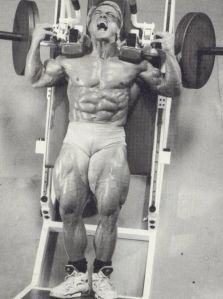My old coaches used to say “The legs feed the wolf! There are few sports where having big, strong legs does not carry over into performance. Many people struggle to build leg size and strength while others have no issues at all. This post will discuss some factors which can influence growth of the leg musculature and how one can use this knowledge to their advantage.
Muscle is not all the same; there are several types and subgroups with different characteristics. Mostly when dealing with skeletal muscle we define the fibers as either Type 1 (Oxidative or Slow twitch) or Type 2 (Glycolytic or Fast twitch). Every muscle is made up of bundles of muscle fibers. Each bundle is from all of the same fiber type and innervated by a single nerve. The bundle and nerve assembly is known as a Motor Unit (MU).
Type 1 fibers tend to be smaller in size and produce less force. They also have excellent blood supply and mitochondrial density which makes them very efficient at oxidative metabolism. This means they don’t fatigue easily. Type 2 fibers are larger in size and more powerful. Unlike Type one they are not so efficient at oxidation and rely heavily on glycolysis, intramuscular ATP and Creatine Phosphate stores for energy. They are much more fatiguable than Type 1 fibers.
The recruitment of the muscle fibers is in order of size, from small to large. The rate and quantity of recruitment will depend on the activity. Slow, low force movements may only require a small recruitment of some type 1 fibers, whereas a heavy lift or sprint will additionally recruit a large portion of type 2 fibers.
When we are born we are genetically predisposed to having a larger distribution of one fiber type over another. With training we can influence a switch over, from one fiber type to another. The fibers will be persuaded to take on new characteristics rather than switch totally. In our earlier years of training and sport we have a large influence on the muscle fibers as they develop. In addition, our genetic makeup will naturally direct us into sports we are suited to physiologically as we are more likely to have success.
When we look at body parts and muscles, the fiber distribution can be influenced by the function. For example forearm muscles contain higher amounts of type one fibers, as grip endurance is required for relatively constant movement of hands and fingers. Legs are similar because we spend relatively large durations of time on our legs, walking and standing etc. For this reason legs will always have a relatively large amount of type 1 fibers.
Micro trauma to the fibers is the catalyst for growth. When we recover, micro tears in the fibers are repaired and the fibers become larger and stronger. Tension and metabolic stress are the two things that will cause stress and trauma. Time under tension (TUT) has long been regarded as a key factor in muscle growth. The more time a fiber is placed under tension the more damage created. In addition metabolic stress can also be quite effective at creating trauma. All we have to do is look at a track cyclist or sprinters legs to demonstrate this.
Putting this knowledge into practice is pretty simple. In order to successfully create hypertrophy in the musculature we must stimulate and cause trauma to both sets of fibers. The challenge with type 1 fibers is that they are harder to fatigue. They need higher volume to do this, and so a higher rep strategy should be employed. The challenge with the type 2 fibers is activation. Heavier and more explosive lifts are needed to activate and fatigue them. Lower reps with heavier weight, combined with some power and sprint training will be needed to promote growth of these fibers.

This not only applies to athletes but also to bodybuilders. The secret to growth is to cover all your bases and keep things simple and consistent. Using a combination of high and low rep training will provide a good overall stimulation making sure you are covering everything. When used as a part of a simple progressive training plan and combined with adequate recovery any athlete will build bigger stronger legs. The key point is to target the fibers effectively so they respond. If you rely on one technique exclusively it is unlikely that you will have long term success.
As with most training, athletes must try and learn their weakness and how to fix them. They can then target the issues with a balanced program to give them a well rounded base. The more familiar they are with the physiological factors involved the more effective a training program can be!
Follow on Facebook https://www.facebook.com/HamiltonSport1Official
Or Twitter @Hamiltonsport1
